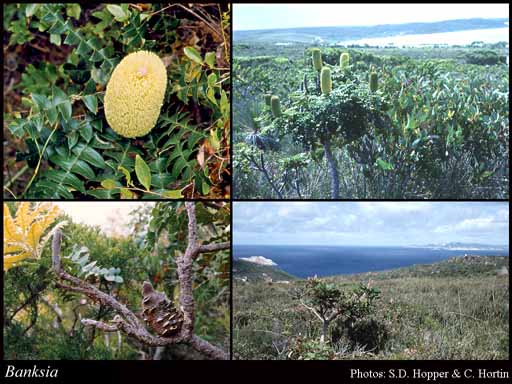- Reference
- Suppl.Pl. 15, 126 (1782)
- Name Status
- Current







Scientific Description
Common name. Banksias. Family Proteaceae.
Habit and leaf form. Trees, or shrubs; evergreen. Mesophytic, or xerophytic. Heterophyllous, or not heterophyllous. Leaves small to medium-sized; alternate, or whorled (rarely); spiral; leathery; petiolate; non-sheathing; aromatic, or without marked odour; edgewise to the stem, or with ‘normal’ orientation; simple; epulvinate. Leaf blades dissected (to deeply divided), or entire; flat; elliptic, or oblong, or obovate, or linear; when simple/dissected pinnatifid; one-veined, or pinnately veined. Leaves without stipules. Leaf blade margins entire, or crenate, or dentate; flat, or revolute. Leaves without a persistent basal meristem. Leaf anatomy. Hairs present, or absent. Branched hairs absent. Stem anatomy. Secondary thickening developing from a conventional cambial ring.
Reproductive type, pollination. Fertile flowers hermaphrodite. Unisexual flowers absent. Plants hermaphrodite. Entomophilous, or ornithophilous, or pollinated by unusual means (by small marsupials).
Inflorescence and flower features. Flowers aggregated in ‘inflorescences’; in pairs, subtended by a common bract; in spikes, or in heads. The terminal inflorescence unit racemose (or two flowered). Inflorescences terminal; dense spikes with woody axes, usually globular to cylindric; with involucral bracts, or without involucral bracts. Involucral bracts often deciduous, or persistent. Involucral bracts not conspicuous. Inflorescences pseudanthial, or not pseudanthial. The fruiting inflorescence conelike. Flowers sessile; bracteate; small to large (often very showy); regular, or somewhat irregular; when irregular, zygomorphic. The floral asymmetry when present, involving the perianth and involving the androecium. Flowers 4 merous; cyclic; tetracyclic, or tricyclic. Floral receptacle developing a gynophore, or with neither androphore nor gynophore. Free hypanthium absent. Hypogynous disk present; extrastaminal; of separate members (translucent scales). Perianth of ‘tepals’; 4; 1 -whorled; free (limb much shorter than the claw); cream, or yellow, or orange, or red, or pink, or brown. Androecium 4. Androecial members adnate; all equal, or markedly unequal; free of one another; 1 -whorled. Stamens 4; isomerous with the perianth; shortly filantherous, or with sessile anthers. Anthers cohering, or connivent, or separate from one another; more or less basifixed; non-versatile; dehiscing via longitudinal slits; introrse; four locular; tetrasporangiate; appendaged (? via the elongated connective), or unappendaged. Gynoecium 1 carpelled. The pistil 1 celled. Gynoecium monomerous; of one carpel; superior. Carpel fully closed, or incompletely closed; stylate; apically stigmatic; 2 ovuled. Placentation marginal, or apical. Ovary sessile. Ovules funicled, or sessile; horizontal; non-arillate; orthotropous, or anatropous, or amphitropous, or hemianatropous.
Fruit and seed features. Fruit falling from the plant before the next growing season, or persistent; non-fleshy. The fruiting carpel dehiscent, or indehiscent; a follicle. Follicles compact; septate (septum woody). Gynoecia of adjoining flowers combining to form a multiple fruit, or not forming a multiple fruit. The multiple fruits coalescing, or not coalescing. Fruit 0–2 seeded. Seeds non-endospermic; compressed; winged. Seed wings not encircling body (wings terminal, membranous). Embryo well differentiated. Cotyledons 2(–8). Embryo straight.
Special features. Stamens inserted within a concavity near the end of a perianth segment.
Geography, cytology, number of species. Native of Australia. Not endemic to Australia. Australian states and territories: Western Australia, South Australia, Northern Territory, Queensland, New South Wales, Victoria, Australian Capital Territory, and Tasmania. Northern Botanical Province, Eremaean Botanical Province, and South-West Botanical Province. South West Western Australia and nearby regions, eastern Australia from Eyre Peninsula (South Australia) to Tasmania and north Queensland, and across tropical Australia extending to Papua New Guinea, Irian Jaya and the Aru Islands.
Etymology. After Sir Joseph Banks (1743–1820), prominent patron of the natural sciences; for over 40 years president of the Royal Society; sailed around the world with Captain Cook 1768–71; collected the largest private herbarium in Europe, about 30 000 species. As a friend of George III he was virtually director of the royal gardens at Kew.
Taxonomic Literature
- George, Alexander S. 2008. Further new taxa in Banksia (Proteaceae: Grevilleoideae).
- Hollister, Chris; Lander, Nicholas; Thiele, Kevin 2008. Keys to the Proteaceae of Western Australia. Dept. of Environment & Conservation.. [Kensington, W.A.]..
- Olde, Peter M.; Marriott, Neil R. 2002. One new Banksia and two new Grevillea species (Proteaceae: Grevilleoideae) from Western Australia.
- Wheeler, Judy; Marchant, Neville; Lewington, Margaret; Graham, Lorraine 2002. Flora of the south west, Bunbury, Augusta, Denmark. Volume 2, dicotyledons. Australian Biological Resources Study.. Canberra..
- Australian Biological Resources Study 1999. Flora of Australia. Volume 17B, Proteaceae 3, Hakea to Dryandra. CSIRO Publishing.. Canberra..
- George, A. S. 1996. Notes on Banksia L.f. (Proteaceae).
- Blackall, William E.; Grieve, Brian J. 1988. How to know Western Australian wildflowers : a key to the flora of the extratropical regions of Western Australia. Part I : Dicotyledons (Casuarinaceae to Chenopodiaceae). University of W.A. Press.. [Perth]..
- George, A. S. 1988. New taxa and notes on Banksia L.f. (Proteaceae).